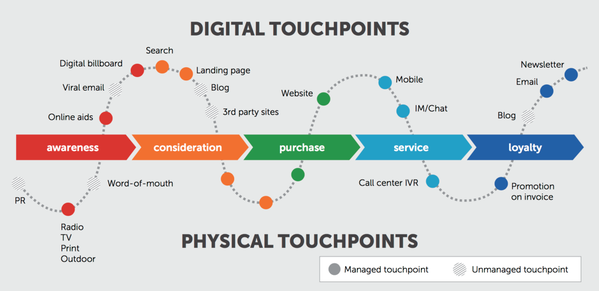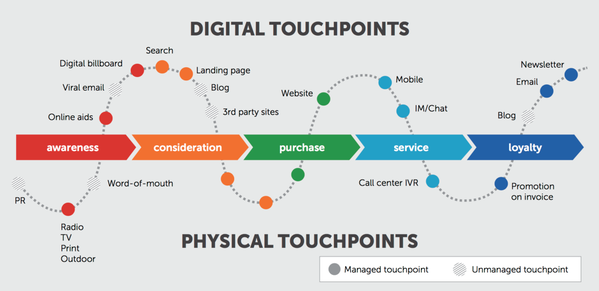Customer Centricity Always Wins

When implementing new technology to improve the customer experience (CX), keep your focus on the customer rather than the technology. This isn’t a new concept, but it’s one that requires consistent reiteration.

During the recent Adobe Summit 2019, Satya Nadella (CEO, Microsoft) asked Shantanu Narayen (CEO, Adobe) for the event highlights and key takeaways. Shantanu highlighted the shift toward digital transformation to improve the customer experience and how enterprise architecture should enable this transformation from behind the scenes.

A customer experience — good or bad — is determined by the quality of all consumer encounters with all of a brand’s touchpoints. This means that every customer encounter across every product and service, independent of channel or interface (physical or virtual) influence the customer’s perception of the brand. It’s a mosaic made up of many individual touchpoints. McKinsey & Company explains it well, here: ‘The consumer decision journey’.
When a consumer is faced with a big decision, like abandoning a known brand for a competitor, that mosaic impression of a brand (favorable or otherwise) is what drives the decision making process.
At the 2019 CXO Series on Digital Industrialization which I attended on April 26th 2019, the discussion topic for our panel was, Understanding the Key Elements and Managing Inter-dependencies in Implementing Digital Transformation Strategies.
Our discussion centered around three major obstacles:
- Good Data Management
- Consistent & Aligned Business Processes
- A Focus on the Customer Experience
Again, the customer experience…
I used a couple of personal experiences to highlight key challenges and opportunities in planning and implementing digital transformations without loosing site of the customer experience, which I’ve expanded on below.
Customer Experience (CX) #1: Auto Insurance Renewals
It’s a thing of the past now, but insurance agents previously required an appointment for signatures on auto insurance renewals. This had to be done in advance so that the policy department could process the renewal and send the updated policy by mail.
Today, it’s all done online and you’ll have an updated policy in your email inbox in under ten minutes (if not less).
When done right, it’s an incredible experience. Here’s how it went wrong, for me:
1, I got the first reminder call from the agent four weeks before my policy expiry date.
2, Over the next three weeks, I received at least 10 additional reminder calls. I answered some and ignored most. On one occasion, I vented my frustration and got an apology.
3, Over the next few days, I renewed my policy online and I thought the trouble was over...
4, I received another call. This time, the insurance company wanted to discuss how to renew an expired policy. I struggled to stay polite as the agent explained that the system had generated a task and she was simply doing her job.
So what might have happened here?
- The insurance company may have piecemeal systems cobbled together from one or more task-specific applications.
- There’s obviously no sharing (or certainly not the right sharing) of data across applications, channels or departments. So it’s really, “Data management? What data management?”
When a company’s CRM or service software doesn’t track all interactions and tie them together — from a customer-centric perspective — across all channels, (email, phone, social media, live chat, etc.) the customer WILL experience pain.
Customer Experience (CX) #2: Buying a Laptop Online
About 25 years ago, this Fortune 100 company started selling PCs online. You could order a computer and the company would send it to you directly from the factory. They surprised the world with their efficient supply chain, something they continue to do today.
1, I completed an online order form with my custom requirements and filled in my personal information, including place of work. Soon after, I received an email confirmation with links to track the status of my order.
2, Within minutes, I could see the status being updated for several tasks, including a notification that production was underway. I was in awe.
3, I clicked over to the generated invoice and noticed a problem: My company’s name was listed above my name, however, this purchase wasn’t intended as a business transaction. This was a personal purchase. I needed to rectify this.
4, I called their customer care team and explained. A very courteous representative assured me that the problem would be rectified. We disconnected, and I thought the situation was resolved. A few minutes later, the representative called back to say that making the required change would take 5–7 business days. Wow, a full week to flip the field entries on a form.
5, The next few weeks were painful as I listened to a helpless company representative fail to move things along with her finance team. After three long weeks, I received a call that the laptop would arrive the next day. But the final blow came when the courier company phoned me on delivery day and asked me to talk to “The Company” because the invoiced address didn’t match the delivery address.
So what might have happened here?
- Edge case testing? The system design is very well optimized, but did not account for edge case testing.
- Not all processes have been optimized: The production processes have been optimized to reduce inventory and wait times, but do other business processes share the same objective?
- Ineffective data management: Leading to loss in data integrity across processes.
Start and End with the Customer
In summary, the applications and systems a company uses can play a major role in the overall customer experience, even if they’re backend systems or data feeds that the customer never sees.
Technology solutions and digital initiatives need to complement the existing customer experience. Adding digital components to the customer journey that don’t directly benefit the customer, or are superfluous to the company’s value proposition, will only make the experience more complicated and confusing.
Digital transformations are more likely to succeed when technology & marketing CXOs work in tandem to jointly focus on delivering an outstanding user experience at each customer touchpoint.



